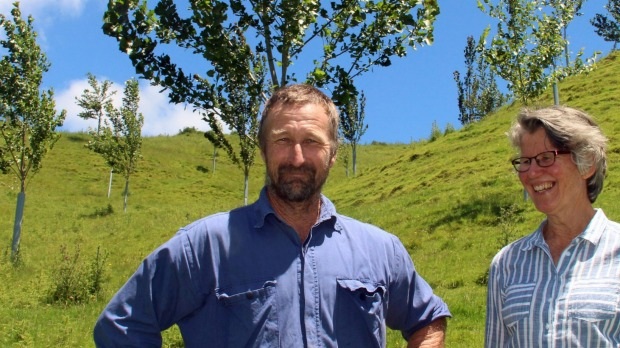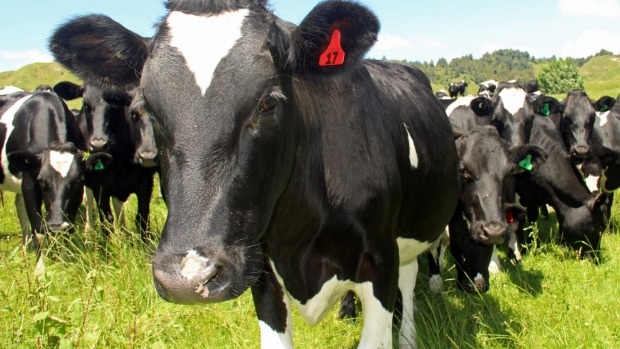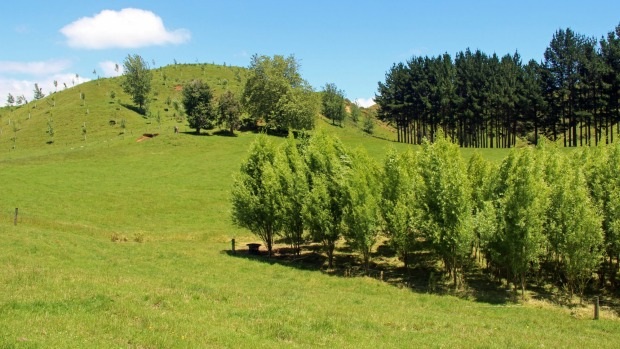Trees grown for shade, shelter and fodder on remote farm
Posted on January 20, 2017

Eastern Taranaki farmers Hugh and Maureen Paterson say the past decade has given them a strong belief in the benefits of poplars and willows.
They farm 231 hectares in the Strathmore district about 30 kilometres inland from Stratford on the Forgotten World Highway (Ohura Road). While relatively remote, the farm is also visible to a growing number of tourists using the highway.
Location and accessibility were also the reasons behind the Paterson's farm being suitable for a poplar trial after they offered the farm to Poplar and Willow Research Trust general manager Ian McIvor.
"We heard Ian speak at a Beef + Lamb NZ roadshow field day on drought tolerance and erosion control a few years ago. I said if he ever wanted to do a trial in Taranaki, we were keen… and here we are with two blocks of 100 in each block. This is the third summer for the older ones."

The first planting of the trial at Paterson's farm, Mangaotuku, was in 2014 with a second planting a year later.
The survival, height and diameter growth of the trees are measured annually for the first three years then at regular intervals for the life of the trial, which is expected to be at least 15 years.
The work is part of a national trial of experimental poplars, Populus maximowiczii x trichocarpa, bred at Plant & Food Research for the New Zealand Poplar and Willow Research Trust. The experimental trees are planted with several commercial poplar clones to compare their growth, form, tolerance to wind, tolerance to rust and response to stock presence.
The Taranaki trial site is one of six around New Zealand – each in a different climatic zone. Farmers plant the poles according to a supplied planting plan and protect them with a dynex sleeve and exclude cattle from the trial area for three years. Trial poplars are planted at a spacing of 10 metres by 10m in randomised blocks with each clone represented once in each row.

Hugh says they have planted poplars and willows across the farm in the past two decades for shade, shelter and fodder.
He says their interest in the trees started after he read something written by McIvor about poplars and willows. The couple had planted poplar shelter-belts with one wire each side, as well as a block of solid planting, and at the recommendation of the Taranaki Regional Council they have a winter wet area planted with willows that is grazed regularly by cattle.
About half of the Mangaotuku Stream that runs through the middle of the farm has been planted.
The farm has 15ha of pine trees in a few small woodlots on unproductive or steep land and the Patersons are planting poplars for erosion control on the hill country, frequently referring to their council farm plan done in March 1999.
"We've been planting mostly kawa poplars because we cut our own poles from the shelter belts. However, kawa aren't ideal for steeper plantings so we get poles of different varieties from Kevin Cash at the Taranaki Regional Council. They have better tolerance for harder, drier hill country. They're also a smaller, more compact tree."
The couple are watching the poplar trial with interest but results aside, Hugh says it's good to be helping McIvor and another scientist Trevor Jones.
"I try to keep up with what they're doing. They're doing good work. It's good science."
Changes in the farm's stocking policies have seen the couple develop a fondness for dairy heifers.
They used to run bulls and had double the number of sheep – all capital stock, Hugh says.
"We've moved out of bulls and become dairy heifer graziers, which suits our style. The stock we get are uniformly good, picked and raised by experts."
The farm carries 400 heifers from May to May on private contracts with a handful of dairy farmers. Most of the heifers are on a set rate, not weight gain.
"The heifers come onto the farm at around 200 kilograms and go home around 400-430kg. They're not big heifers but we have a relatively high stocking rate and average weight gains… acceptable weight gains."
Jersey bulls are hired in October/November. Heifers are pregnancy tested before they go home. Weaner heifers have been added to the line-up this season.
"We were understocked this year so we have 50 weaner heifers grazing as well," says Maureen.
"They're so tiny alongside the in-calf heifers you don't think they're ever going to grow as big."
Maureen does most of the heifer stock work, which can be time consuming in winter moving electric fences.
"The heifers are moved every day in winter and every two days in summer. They're a pleasure to work with. We have two dairy farming neighbours so bulls aren't really an option any more. We're set up for dairy grazing and are enjoying it. Since we've done the subdivision and the troughs can be rolled from one break to another, life is a lot easier. Usually there are no more than 70 in a mob so it's manageable."
Hugh says they like the cash flow of the dairy grazing system "year in and year out". He says the dairy heifer side of the business equates to about 70 per cent of the income but 50 per cent of the work.
"Sheep are a lot more work than income especially the way we do it. They can get the squeeze. They're on the harder hill country and get less money spent on them."
As well as 50 steers, Mangaotuku carries 600 romney ewes and 200 hoggets with rams from Wairere Romneys.
"I liked Wairere's selection pressure with their big numbers. We've been scanning here for a long time but because the dairy heifers take up the good country we have an averagely high scanning percentage and an averagely low docking percentage. We do look after the twins better though.
"The sheep are treated a bit like second-class citizens at the moment but once we finish the fencing on the heifer country we'll have more money and time to spend on fencing and fertiliser and water on the sheep country. We have three neighbours who farm sheep properly and do it well. One day we will get there."
The Paterson family bought the medium-hill country farm in 1989 when it carried more sheep.
"My brother had been here before us but he wanted a change so we came back from Australia in 1992 and started learning," says Hugh.
"It was bought as a family purchase originally and we've been slowly paying the family out, which is why the steady income and cash flow from dairy grazing has been a good thing.
"I had been overseas a long time and only came back because my brother wanted to move on and we had a son by then as well, so it was time for a change."
South African-born Maureen, who met Hugh while the pair were working in Botswana, says she moved around a lot as a child and wanted to bring up their children in one house – Emily is now living in Auckland and Sam is teaching English in Korea.
This story written by Kate Taylor can be seen on the Stuff website.